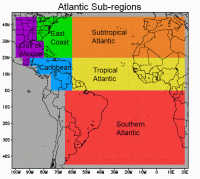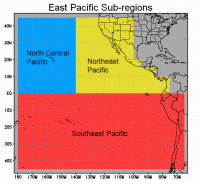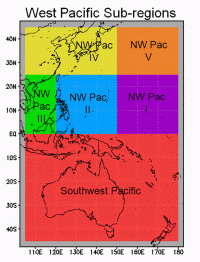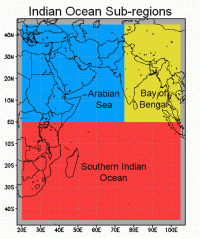NOTE: NESDIS maintains the official operational product, which can be found at www.ssd.noaa.gov/PS/TROP/TCFP/index.html.
NCEP global forecasts, Reynolds weekly sea surface temperature, and GOES-East, GOES-West, MTSAT-1R and Meteosat-7 channel-3 (water vapor) imagery are used as input to an algorithm to estimate the probability of tropical cyclone formation within 500km of each grid point within the next 48 hours 45 S to 45 N and 0 to 360 E. The product domain is divided into 7 main basins (below) based on satellite coverage and warning agency boundaries.

Figure: TCFP basins
INPUT PARAMETERS:
- CLIM: Climatological TC formation probability. This was derived from the NHC Atlantic and east Pacific best track files from 1949-2010. Formation was defined as the first entry of tropical depression or higher in the best track. Extratropical cases were excluded.
- PLND: The percent of the area covered by an r=500km circle covered by land
- DNST: The closest distance to any existing tropical cyclone.
- RSST: The average weekly Reynold's SST.
- VSHD: The average 850-200 hPa vertical shear.
- RVOR: The average 850 hPa relative vorticity.
- THDV: The average vertical instability parameter, defined as the vertical average temperature difference between the equivalent potential temperature of a parcel lifted from the surface to 200 hPa, and the saturation equivalent potential temperature of the environment.
- HDIV: The average 850 hPa horizontal divergence.
- PCCD: The percent of channel 3 pixels colder than -40 degree. All full disk images within 3 hours after and 6 hours before each synoptic time are include, so that this parameter represents the amount of sustained deep convection.
- BTWM: The average channel 3 brightness temperature, after the cold pixels in parameter 9 above have been eliminated. This parameter is a measure of mid- to upper-level moisture.
- MSLP: The average mean sea level pressure.
- TADV: The average 850 hPa horizonal temperature advection.
**Note: all parameters except DNST computed over a 500km radius area centered on each grid point
CLIMATOLOGY:
Climatological input parameters are computed over the following time periods:
- CLIM: 1949-2010
- RSST,VSHD,RVOR,THDV,HDIV,MSLP,TADV: 1995-2010
- BTWM,PCCD (N Atlantic): 1995-2010
- BTWM,PCCD (NE/NCentral Pacific): 1998-2010
- BTWM,PCCD (NW Pacific): 2000-2010
- BTWM,PCCD (Indian Ocean, S Pacific): 2005-2010
- BTWM,PCCD (S Atlantic): 2008-2010
ALGORITHM METHODOLOGY:
The formation probability is calculated by a three-step algorithm. First, all cases where input parameter values exceed predetermined thresholds are screened out. Then, a statistically-derived linear function of the input parameters is used to compute the linear discriminant function value at each grid point that passed screening. Lastly, a statistically-derived relationship between the linear discriminant function value and the corresponding past TC formation occurence frequecy at used to determine the probability of TC formation.
TC formation probability (TCFP) is computed for each 24-hr forecast interval (0-24hr and 24-48hr) based on the 24-hr averages of the input parameters. The cumulative probability of TC formation (CUMP) is computed using the formula:
CUMP(0-48h) = TCFP(0-24h) + TCFP(24-48h) - [TCFP(0-24h)*TCFP(24-48h)]
SUBREGION AVERAGES & SUMS:
To provide some time continuity of the product, the formation probability and the primary parameters used in the screening and discrimination analysis are summed (probabilities) or averaged (all other parameters) over 6, 3, 6, and 3 sub-basins for the Atlantic, Eastern Pacific, Western Pacific, and Indian Ocean basins, respectively. Time series products comparing the current and climatological parameters over the sub-basins are provided on the web site.
 |
 |
 |
 |
| Figure: TCFP sub-basins |
REFERENCES:
Schumacher, A. B., M. DeMaria, J. A. Knaff, 2009: Objective Estimation of 24-h Probability of Tropical Cyclone Formation. Wea. Forecasting, 24, 456-471.